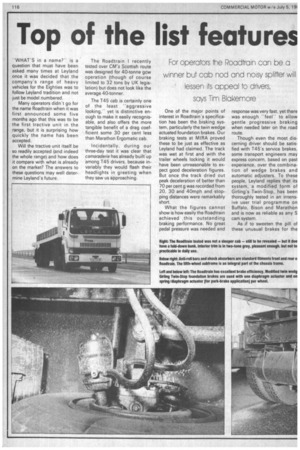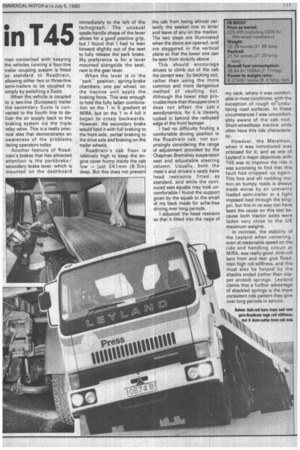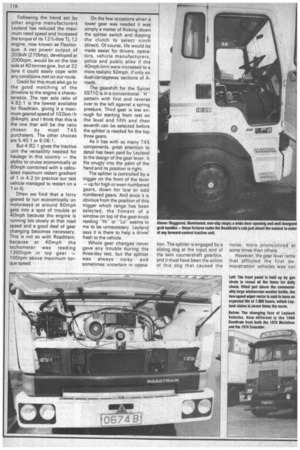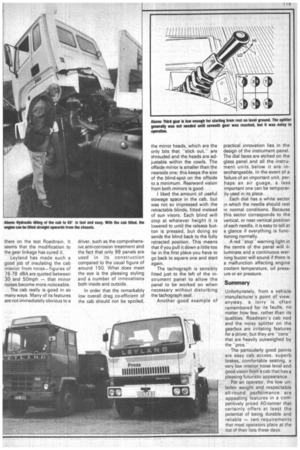Top of the list features in T45
Page 118

Page 119

Page 120

Page 121

If you've noticed an error in this article please click here to report it so we can fix it.
For operators the Roadtrain can be a winner but cab nod and noisy splitter will lessen its appear to criyers, says Tim Blakemore
"WHAT'S in a name?" is a question that must have been asked many times at Leyland once it was decided that the company's range of heavy vehicles for the Eighties was to follow Leyland tradition and not just be model numbered.
Many operators didn't go for the name Roadtrain when it was first announced some five months ago that this was to be the first tractive unit in the sange, but it is surprising how quickly the name has been accepted.
Will the tractive unit itself be so readily accepted (and indeed the whole range) and how does it compare with what is already on the market? The answers to these questions may well determine Leyland's future The Roadtrain I recently tested over CM's Scottish route was designed for 40-tonne gcw operation (though of course limited to 32 tons by UK legislation) but does not look like the average 40-tonner.
The T45 cab is certainly one of the least "aggressive looking,'" yet is distinctive enough to make it easily recognisable, and also offers the more tangible benefit of a drag coefficient some 30 per cent less than Marathon Ergornatic cab.
Incidentally, during our three-day test it was clear that camaraderie has already built up among T46 drivers, because invariably they would flash their headlights in greeting when they saw us approaching. One of the major points of interest in Roadtrain's specification has been the braking systern, particularly the twin wedge actuated foundation brakes. Our braking tests at MIRA proved these to be just as effective as Leyland had claimed, The track was wet at first and with the trailer wheels locking it would have been unreasonable to expect good deceleration figures. But once the track dried out peak deceleration of better than 70 per cent g was recorded from 20, 30 and 40mph and stopping distances were remarkably short.
What the figures cannot show is how easily the Roadtrain achieved this outstanding braking performance. No great pedal pressure was needed and response was very fast, yet there was enough "feel" to allow gentle progressive braking when needed later on the road route.
Though even the most discerning driver should be satisfied with T45's service brakes, some transport engineers may express concern, based on past experience, over the combination of wedge brakes and automatic adjusters. To these people, Leyland replies that its system, a modified form of Girling's Twin-Stop, has been thoroughly tested in an intensive user trial programme on Buffalo, Bison and Marathon and is now as reliable as any S cam system.
As if to sweeten the pill of these unusual brakes for the men concerned with keeping the vehicles running a four-line trailer coupling system is fitted as standard to Roadtrain, allowing either two or three-line semi-trailers to be coupled to simply by switching a Suzie.
When the vehicle is coupled to a two-line (European) trailer the secondary Suzie is connected to the fourth line to deliver the air supply back to the braking system via the triple relay valve. This is a really practical idea that demonstrates an awareness of the problems facing operators today.
Another feature of Roadtrain's brakes that has attracted attention is the parkbrake/ secondary brake lever, which is mounted on the dashboard immediately to the left of the tachograph. The unusual spade-handle shape of the lever allows for a good positive grip, but I found that I had to lean forward slightly out of the seat to fully release the park brake. My preference is for a lever mounted alongside the seat, next to the gear lever.
When the lever is in the "park" position, spring-brake chambers, one per wheel, on the tractive unit apply the braking force. This was enough to hold the fully laden combination on the 1 in 5 gradient at MIRA, but on the 1 in 4 hill it began to creep backwards. However, the secondary brake 'would hold it with full braking to the front axle, partial braking to the drive axle and braking on the trailer wheels.
Roadtrain's cab floor is relatively high to keep the engine cover hump inside the cab low — just 241 mm (9.5in) deep. But this does not prevent the cab from being almost certainly the easiest one to enter and leave of any on the market. The two steps are illuminated when the doors are opened, and are staggered in the vertical plane so that the lower one can be seen from directly above.
This should encourage drivers to climb out of the cab the correct way, by backing out, rather than using the more common and more dangerous method of vaulting out. Although the lower step protrudes more than theupperone it does not affect the cab's aerodynamics, for it is cleverly tucked in behind the radiused edge of the front bumper.
I had no difficulty finding a comfortable driving position in the Roadtrain cab, not surprisingly considering the range of adjustment provided by the Chapman Bremshey suspension seat and adjustable steering column. Usually, both the mate's and drivers's seats have head restraints fitted as standard, and while the contoured seat squabs may look uncomfortable I found the support given by the squab to the small of my back made for ache-free driving over long periods.
I adjusted the head restraint so that it fitted into the nape of my neck, where it was comfortable in most conditions, with the exception of rough or undulating road surfaces. In these circumstances I was uncomfortably aware of the cab nod. Short-wheelbase tractive units often have this ride characteristic.
However, the Marathon, when it was introduced was criticised for it, and as one of Leyland's major objectives with T45 was to improve the ride it was surprising to find that this fault had cropped up again. This fore and aft nodding motion on bumpy roads is always made worse by an unevenly loaded semi-trailer or a light imposed load through the kingpin, but this in no way can have been the cause on this test because both tractor axles were laden very close to the UK maximum weights.
In contrast, the stability of the Leyland when cornering, even at reasonable speed on the ride and handling circuit at MIRA, was really good. Anti-roll bars front and rear give Roadtrain high roll stiffness, and this must also be helped by the shackle ended (rather than slipper ended) springs. Leyland claims that a further advantage of shackled springs is the more consistent ride pattern they give over long periods in service.
Following the trend set by other engine manufacturers Leyland has reduced the maximum rated speed and increased the torque of its 121/2-litre TL 12 engine, now known as Flexitorque. A net power output of 203kW (270bhp), developed at 2000rpm, would be on the low side at 40 tonnes gcw, but at 32 tons it could easily cope with any conditions met on our route.
Credit for this must also go to the good matching of the driveline to the engine's characteristics. The rear axle ratio of 4.82:1 is the lowest available for Roadtrain, giving it a maximum geared speed of 102km / h (64mph), and I think that this is the one that will be the ratio chosen by most T45 purchasers. The other choices are 5.40:1 or 6.06:1.
But 4.82:1 gives the tractive unit the versatility needed for haulage in this country — the ability to cruise economically at 60mph combined with a calculated maximum restart gradient of 1 in 4.2 (in practice our test vehicle managed to restart on a 1 in 4).
Often we find that a lorry geared to run economically on motorways at around 60mph gets into a spot of trouble at 40mph because the engine is running too slowly at that road speed and a good deal of gear changing becomes necessary. This is not so with Roadtrain, because at 40mph the tachometer was reading 1300rpm in top gear — .100rpm above maximum torque speed. On the few occasions when a lower gear was needed it was simply a matter of flicking down the splitter switch and dipping the clutch to select ninth (direct). Of course, life would be made easier for drivers, operators, vehicle manufacturers, police and public alike if the 40mph limit were increased to a more realistic 50mph, if only on dual-carriageway sections of Aroads.
The gearshift for the Spicer SST10 is in a conventional ' H " pattern with first and reverse over to the left against a spring pressure. Third gear is low enough for starting from rest on the level and fifth and then seventh can be selected before the splitter is needed for the top three gears.
As it has with so many T45 components, great attention to detail has been paid by Leyland to the design of the gear lever. It fits snugly into the palm of the hand and its position is right.
The splitter is controlled by a trigger on the front of the lever — up for high or even numbered gears, down for low or odd numbered gears. And since it is obvious from the position of this trigger which range has been selected, the fitment of a window on top of the gear-knob reading "Hior "Loseems to me to be unnecessary. Leyland says it is there to help a driver fresh to the vehicle.
Whole gear changes never gave any trouble during the three-day test, but the splitter was always noisy and sometimes uncertain in opera tion. The splitter is engaged by a sliding dog at the input end of the twin countershaft gearbox, and it must have been the action of this dog that caused the
noise, more prono-unced at some times than others.
However, the gear lever rattle that afflicted the first demonstration vehicles was not there on the test Roadtrain. It seems that the modification to the gear linkage has cured it.
Leyland has made such a good job of insulating the cab interior from noise—figures of 76-78 dBA are quoted between 30 and 50mph — that minor noises become more noticeable.
The cab really is good in so many ways. Many of its features are not immediately obvious to a driver, such as the comprehensive anti-corrosion treatment and the fact that only 98 panels are used in its construction compared to the usual figure of around 150. What does meet the eye is the pleasing styling and a number of innovations both inside and outside.
In order that the remarkably low overall drag co-efficient of the cab should not be spoiled,
the mirror heads, which are the only bits that "stick out,are shrouded and the heads are adjustable within the cowls. The offside mirror is smaller than the nearside one; this keeps the size of the blind-spot on the offside to a minimum. Rearward vision from both mirrors is good.
I liked the amount of useful stowage space in the cab, but was not so impressed with the retractable blinds, fitted instead of sun visors. Each blind will stop at whatever height it is lowered to until the release button is pressed, but doing so sends the blind back to the fully retracted position. This means that if you pull it down a little too far in the first place you have to go back to square one and start again.
The tachograph is sensibly fitted just to the left of the instrument panel to allow the panel to be worked on when necessary without disturbing the tachograph seal.
Another good example of practical innovation lies in the design of the instrument panel. The dial faces are etched on the glass panel and all the instrument units below it are interchangeable. In the event of a failure of an important unit, perhaps an air guage, a less important one can be temporarily used in its place.
Each dial has a white sector in which the needle should rest in normal conditions. Because this sector corresponds to the vertical, or near vertical position of each needle, it is easy to tell at a glance if everything is functioning normally.
A red "stop" warning light in the centre of the panel will illuminate and a continuous warning buzzer will sound if there is a malfunction affecting engine coolant temperature, oil pressure or air pressure.
Summary Unfortunately, from a vehicle manufacturer's point of view, anyway, a lorry is often remembered for its faults, no matter how few, rather than its qualities. Roadtrainls cab nod and the noisy splitter on the gearbox are irritating features for a driver, but they are -cons" that are heavily outweighed by the "pros."
The particularly good points are easy cab access, superb brakes, comfortable seating, a very low interior noise level and good vision from a cab that has a pleasing futuristic appearance.
For an operator, the low unladen weight and respectable all-round performance are appealing features in a competitively priced 40-tonner that certainly offers at least the potential of being durable and reliable — two requirements that most operators place at the top of their lists these days.
IN BRIEF
Price as tested: £25,495 (including £500 for fifth-wheel installation) Weight.
32.39 tonnes (31 88 tons) Payload: 21 54 tonnes (21 20 tonsl tons) Overall fuel consumption; 36 64 lit 100km (7 71rnpg Power to weight ratio:
6 2/kW torilw t8 4 / bhp .-' ton)












































































































































































































